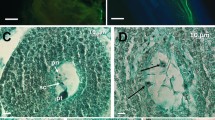Summary
Embryo callus was produced in up to 12% of the undeveloped seeds of the interspecific cross L. esculentum cv. VFNT cherry x L. peruvianum LA1283-4, a cross which does not produce viable seeds. Plants were produced from 90% of those callus clones by regeneration and rooting. Evidence that these plants were hybrid includes morphology, isoenzyme patterns and fertility relations. Both diploid and tetraploid plants were produced, 40% of the regenerated callus clones producing at least one diploid plant. Thus, up to 4% of the undeveloped seeds plated for callus production eventually yielded diploid hybrid plants. In contrast, among 401 undeveloped seeds dissected, no embryos suitable for embryo culture were found. A backcross of the embryo callus hybrids to the L. esculentum parent has succeeded — producing, as expected, only undeveloped seeds; these undeveloped seeds have produced callus.
Similar content being viewed by others
Literature
Alexander, L.J (1963): Transfer of a dominant type of resistance to the four known Ohio pathogenic strains of tobacco mosaic virus (TMV), from Lycopersicon peruvianum to L. esculentum. Phytopathology 53, 869
Cooper, D.C.; Brink, R.A. (1945): Seed collapse following matings between diploid and tetraploid races of Lycopersicon pimpinellifolium. Genetics 30, 376–401
Henshaw, G.G.; Jha, K.K.; Mehta, A.R.; Shakeshaft, D.J.; Street, H.E. (1966): Studies on the growth in culture of plant cells. I. Growth patterns in batch propagated suspension cultures. J. Exp. Bot. 17, 362–377
Hogenboom, N.G. (1972a): Breaking breeding barriers in Lycopersicon. 1. The genus Lycopersicon, its breeding barriers and the importance of breaking these barriers. Euphytica 21, 221–227
Hogenboom, N.G. (1972b): Breaking breeding barriers in Lycopersicon. 4. Breakdown of unilateral incompatibility between L. peruvianum (L.) Mill. and L. esculentum Mill. Euphytica 21, 397–404
Hogenboom, N.G. (1972c): Breaking breeding barriers in Lycopersicon. 5. The inheritance of the unilateral incompatibility between L. peruvianum (L.) Mill. and L. esculentum Mill. and the genetics of its breakdown. Euphytica 21, 405–414
McGuire, D.C.; Rick, C.M. (1954): Self-incompatibility in species of Lycopersicon sect. Eriopersicon and hybrids with L. esculentum. Hilgardia 23, 101–124
Medina-Filho, H.P. (1980): An electrophoretic variant as a tool for breeding tomatoes for nematode resistance. Ph.D. Thesis, University of California, Davis
Murashige, T.; Skoog, F. (1962): A revised medium for rapid growth and bioassays with tobacco tissue cultures. Physiol. Plant. 15, 473–497
Nettancourt, D. de; Devreaux, M.; Laneri, U.; Cresti, M.; Pacini, E.; Sarfatti, G. (1974): Genetical and ultrastructural aspects of self and cross incompatibility in interspecific hybrids between self-compatible Lycopersicum esculentum and self-incompatible L. peruvianum. Theor. Appl. Genet. 44, 278–288
Ramulu, K.S.; Devreaux, M.; Ancora, G.; Laneri, U. (1976): Chimerism in Lycopersicum peruvianum plants regenerated from in vitro cultures of anthers and stem internodes. Z. Pflanzenzücht. 76, 299–319
Rick, C.M.; Fobes, J.F., Holle, M. (1977): Genetic variation in Lycopersicon pimpinellifolium: evidence of evolutionary change in mating systems. Plant Syst. Evol. 127, 139–170
Rick, C.M.; Tanksley, S.D.; Fobes, J.F. (1979): A pseudoduplication in Lycopersicon pimpinellifolium. Proc. Natl. Acad. USA 76, 3435–3439.
Smith, P.G. (1944): Embryo culture of a tomato species hybrid. Proc. Amer. Soc. Hort. Sci. 44, 413–416
Author information
Authors and Affiliations
Additional information
Communicated by G. Melchers
Rights and permissions
About this article
Cite this article
Thomas, B.R., Pratt, D. Efficient hybridization between Lycopersicon esculentum and L. peruvianum via embryo callus. Theoret. Appl. Genetics 59, 215–219 (1981). https://doi.org/10.1007/BF00265495
Received:
Issue Date:
DOI: https://doi.org/10.1007/BF00265495




